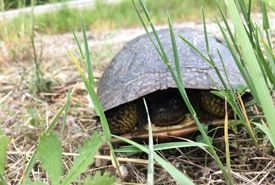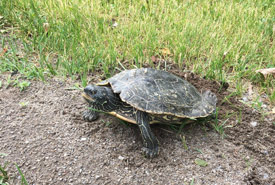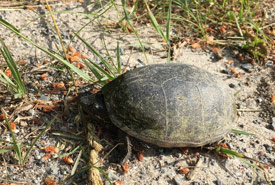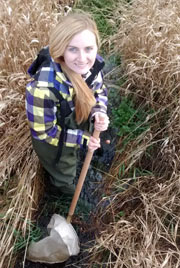Taking time for turtles

Blanding's turtle (Photo by Megan Quinn/NCC staff)
If you’ve been lucky enough to visit the Nature Conservancy of Canada’s (NCC’s) beautiful eastern Ontario properties, you’ll know that they’re mostly made up of two things: large stretches of forest and seemingly never-ending wetlands. Many areas in southern Ontario are highly developed, so the large patches of wetland in eastern Ontario are turtle paradise.

Map turtle nesting (Photo by Megan Quinn/NCC staff)
This doesn’t mean that turtles don’t need our help, however. Because eastern Ontario is also a popular cottage and vacation destination, it means there are many cars on the road and, as a result, many turtle fatalities. With the recent news that all eight of Ontario’s native turtles are now species at risk, every bit of help counts.
Something that you can do for turtles is help them safely cross the road. If you’re unsure how to do this, NCC has an informative video to show you the proper technique.
Helping turtles is something we have incorporated into our field days in eastern Ontario. Between our office at the Queen’s University Biological Station (QUBS) and our properties, we spend most of our driving time on the back roads of the Frontenac Arch. It’s a rare day if we don’t save at least two turtles.

Eastern Ontario's turtle tally (Photo by Megan Quinn/NCC staff)
We’re always on the lookout for turtles we can help safely cross the road. Usually, whoever is in the passenger seat is the designated turtle spotter, while the other passengers are responsible for recording information about the encounter. We even have a tally on the office whiteboard showing how many turtles we’ve saved.

Musk turtle (Photo by Megan Quinn/NCC staff)
But, for as many turtles as we’ve assisted, we’ve also pulled over many times only to realize that the dark blobs we were looking at from afar weren’t turtles at all. Just for fun, I’ve compiled a list of all the objects the QUBS field crew has mistaken for a distressed turtle:
- a hiking boot;
- three coffee cups;
- a rusty metal pipe;
- a large pile of sand;
- a three-legged porcupine;
- two leaves;
- a pizza box;
- five turtle-shaped rocks; and
- a canoe block (something you put a canoe on).
Regardless, it was a good excuse to pick up some garbage and keep our natural areas clean.
So the next time you’re driving and can safely pull over to help a turtle cross the road, I really encourage you to do so. You’ll not only get a big thanks from me, but also from the turtle, who can continue safely on its way.


